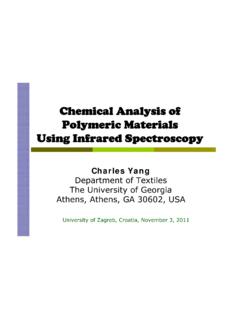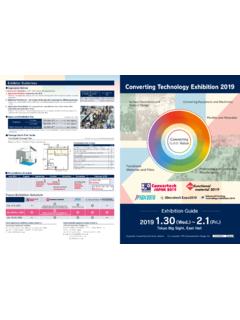Transcription of Negative Air Ion Release and Far Infrared Emission ...
1 Journal of Engineered Fibers and Fabrics 59 Volume 12, Issue 1 2017 Negative Air Ion Release and Far Infrared Emission Properties of Polyethylene terephthalate/Germanium Composite Fiber Zhi Chen, Jian Wang, Jing Li, Yanan Zhu, Mingqiao Ge Key Laboratory of Eco-textiles of Ministry of Education, Jiangnan University, Wuxi CHINA Correspondence to : Mingqiao Ge email: ABSTRACT PET/germanium composite fibers that with Negative air ion Release and far Infrared Emission properties were prepared by adding germanium particles to polyethylene terephthalate (PET) and melt-spinning. The morphology, effect of the germanium content on the Negative air ion Release , far Infrared Emission , thermal and mechanical properties of the fibers were investigated. The germanium particles uniformly disperse in the PET fibers when the concentration ranged from 1% to 3 percent.
2 The value of the Negative air ions released by the PET/germanium composite fibers increased with increasing content of germanium and reached 1470 ions/cm-3 at 3% germanium concentration. The highest far Infrared normal emissivity ( ) was obtained at 3% germanium concentration. The TG and DSC analysis revealed that the two heat histories used had little effect on the PET. The crystallinity of the composite fibers decreased with increasing germanium content. Water fastness testing showed that the PET/germanium composite fibers had excellent and durable Negative air ion Release and far Infrared Emission properties. The breaking strength of the fibers decreased with increasing of the germanium content. INTRODUCTION With the development of functional textile materials which offer enhancement of health, there is an increasing demand for textiles with even greater benefits to body health.
3 Release of Negative air ions, which offer known benefits of air purification, antibacterial deodorization and benefit for healthy, has become an important criteria for determining health benefits of textile product. [1-4]. Additionally, far Infrared radiation is regarded as an indispensable characteristic of healthy materials. Use of healthy fibers to manufacture functional textiles that possess Negative air ion Release and far Infrared Emission properties has become a significant research direction in the field of functional materials. Tourmaline is widely used in applications such as healthy fibrous products [5-6], far Infrared radiation [7-8] and water purification [9-10] because of its Negative air ion Release and far Infrared Emission properties.
4 However, as a rare natural silicate mineral, tourmaline is a nonrenewable resource, and the volume in present in the earth is too low to satisfy industry demand, leading to shortages. Tourmaline is a complex natural borosilicate mineral whose general chemical formula is expressed as XY3Z6Si6O18(BO3)3W4, where X is Na+, Ca2+, K+, or vacancy; Y is Mg2+, Fe2+, Mn2+, Al3+, Fe3+, Mn3+, Cr3+, Ti4+, or Li+; Z is Al3+, V3+, Cr3+, or Mg2+; and W is OH-, F- or O2-[11]. Therefore, it is difficult to obtain quantities of high purity to urmaline. Consequently, the search for an alternate material with similar desirable properties is on-going. Germanium is a semi-metallic element, with 4 unbalanced electrons moving irregularly around the nuclei. When exposed to temperatures above 32 C or changes in atmospheric pressure, one of the irregular electrons escapes from its orbit and produces a Negative electron, which ionizes the surrounding air, resulting in Negative air ions [12].
5 As a consequence of the thermoelectricity and piezoelectricity characteristics explained above and the fact that the human body temperature is C, and the fact that garment pressures generated by human limbs are continually changin g, germanium particles can be used to generate Negative air ions if they were used as a functional additive and doped into the spinning solution and spun into healthy fibers and textiles. In addition, the far Infrared radiation (4-14um) emitted by germanium particles could benefit for body by promoting blood circulation and improving metabolism. It is reasonable to assume that Journal of Engineered Fibers and Fabrics 60 Volume 12, Issue 1 2017 germanium composite fibers and fibrous products could have a wide range of applications as healthy garment and textile products such as underwear, bed sheets, home-furnishing textiles and interior textiles for vehicles.
6 In this research, PET/germanium composite fibers were prepared by melt spinning by adding various levels of germanium particles into the PET spinning solution with the aid of a dispersant. The morphology, effects of content of germanium particles in the PET fibers on the Negative air ion Release , far Infrared Emission and mechanical properties of the fibers were investigated. EXPERIMENTAL DETAILS Materials The Germanium powder (purity of ) was supplied by Jin Quankuang Minerals co., Ltd (Shi Jiazhuang, China); The Polyethylene terephthalate (PET) chips were purchased from Wuxi Taiji Industry Co., Ltd. (Wuxi, China); The soft detergents were purchased from Sinopharm Chemical Reagent Co., Ltd China and the functional additive was prepared by our research team.
7 Preparation of the PET/Germanium Fiber The PET/germanium composite fibers were prepared by melt spinning. The preparation process was divided into two parts. First, the PET chips were dried in an oven at 110 C for 24 h, and then mixed with germanium powder and special dispersants in a high-speed mixer. The mixtures were then extruded in a twin-screw master batch mixer at 270 C to obtain a master-batch. Second, the required ratios of PET chips and master-batch were blended, dried at 110 C, fed to the melt spinning machine and spun at 270 C into the PET/ germanium composite fibers. In this study, 4 different PET/germanium composite fibers were prepared. The add ratio of each component is listed in Table I. A schematic of the melt spinning process is presented in Figure 1.
8 All PET/germanium fibers were spun to linear densities of 150 Denier/36filaments. TABLE I. Compositions of the PET/ germanium fiber. Samples Germanium particles content (Wt %) PET chips (Wt %) a b c d 0 1 2 3 100 99 98 97 FIGURE 1. The preparation process of the PET/germanium composite fiber. Morphology Analysis The surfaces and cross sectional morphologies of the fibers were inspected using a scanning electron microscope (SEM, SU1510, Hitachi, Japan). Thermal analysis (TGA/DSC) Thermogravimetric analysis (TGA) of the PET/germanium composite fibers was carried out using a TGA-Q500 thermogravimetric analyzer (TA, ) which allows the simultaneous detection of mass changes and heat effects during the decomposition of the samples. The samples were ramped from 30 C to 600 C at a heating rate of 10 C /min under nitrogen atmosphere.
9 Thermal analysis of the PET/germanium composite fibers was carried out using TA-Q200 Differential scanning calorimeter (DSC). The Samples were heated to 400 C at 10 C/min to insure complete melting and then cooled to room temperature. to obtain a crystallization curve for each sample. Journal of Engineered Fibers and Fabrics 61 Volume 12, Issue 1 2017 Negative Air Ion Te s t The Negative air ion Release properties were measured by an AIC-2 Negative air ion tester (ALP, ). A diagram of the testing device is shown in Figure 2. Samples were tested according to the Import and Export Functional Textiles of China (SN/T ). FIGURE 2. The testing device for Negative air ions. The composite fiber specimens used for Negative air ions analysis were converted to films with thicknesses of roughly by hot-pressing at 180 C for 5 mins.
10 The hot-pressed film specimens were then cut to dimensions of 10 10 for testing. Before the Negative air ion test, the fiber film specimens were fitted on the friction disk (Figure 2) and kept in the glass shade box for 24 h, during which the temperature and relative humidity were kept at 25 C and 60 percent, respectively. The values of Negative air ions (Vion-) released by the composite fiber film specimens were then calculated at temperatures ranging from 25 C to 80 C. The Vion- determined in the first minute were used as the average value of Negative air ions released by the PET/germanium composite fiber film specimens. Far Infrared Emission Test The far Infrared emissivity (broadband between 4um and 14um) of the samples was tested using a TSS-5X far Infrared radiant emissivity tester (Beijing Hua Rui technology development co.)






